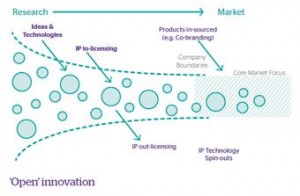The Open Innovation Revolution
 Open innovation has become a modern management tool within corporate innovation management, especially in large multinational corporations. Open innovation has become an important extension to the classical innovation approach which has been traditionally closed innovation within company boundaries.
Open innovation has become a modern management tool within corporate innovation management, especially in large multinational corporations. Open innovation has become an important extension to the classical innovation approach which has been traditionally closed innovation within company boundaries.
Open innovation is the big trend in innovation management, a hot topic in many management conferences and a favorite of consultants and facilitators. During the last decade, many large corporations have established open innovation managers and allocated a significant share of R&D budgets to open innovation.
Country-wise, the USA, Netherland, Germany and France are considered as the top locations in regard to open innovation initiatives, according to Stefan Lindegaard[1], who operates a blog on open innovation.
According to google trends, open innovation is most popular in Europe, especially in UK, Germany, Benelux and Scandinavia, but also in USA, Canada, Brazil, India, South Korea and Australia. The search interest continuously grew from 2004 to 2009 and then remained on a constantly high level.

 Traditionally, in closed innovation all ideas for innovations of a company are provided by employees of that company. For protecting the know-how and intellectual property of the company this has been considered as preferred way of operation ever since the industrial revolution started.
Traditionally, in closed innovation all ideas for innovations of a company are provided by employees of that company. For protecting the know-how and intellectual property of the company this has been considered as preferred way of operation ever since the industrial revolution started.
Open innovation has emerged in recent years as complimentary strategy in which outside ideas, technologies, IP are included in the innovation process.
Numerous social networking websites and portals have emerged[2]. These websites include Innocentive[3], Ninesigma[4], Innoget[5], Openinnovation.eu[6], Ideaconnection[7], Innovationmanagement.se[8], Openinnovation.net/, 15inno.com[9], Ideas4all.com[10], Atizo[11], Innovationsupplychain.com[12], Bulbstorm.com/[13], just to mention a few portals.
What is truly remarkable about portals such as Innocentive is their (claimed) success rate. According to Harvard Business School study , nearly one third of the problems posted on Innocentive were solved within the specified time frame. In other words, a network of external experts managed to solve problems that large corporations with thousands of scientists and massive research budgets had been unable to solve internally.
Procter & Gamble[14] , the American consumer products giant, is one of the pioneers of open innovation.
“P&G’s strategy includes unrelenting focus on innovation. We want to partner with the best innovators everywhere… Connect + Develop is at the heart of how P&G innovates” says Bob McDonald, Chairman of the Board, President & Chief Executive Officer[15].
In future, 3 bio USD of annual growth of P&G are expected to come from products based on external ideas through its Connect & Develop programs.
P&G claims a success rate of > 50% with a hit rate of 90%. However, while past achievements of R&G in open innovation is appreciated, recently doubts have been raised whether P&D would still be an open innovation leader[16].
BASF , the world’s leading chemical company, has joined InnoCentive’s online scientific network as early as 2003.
In specialty chemicals leaders like Eastman Chemicals, Evonik, Dow and Unilever have started to embrace open innovation as well[17].
In Oil & Gas, Shell announced to invest up to hundreds of millions of dollars in technology-oriented companies for the next 6 to 8 years[18]. “Ideas from outside our organisation are of great importance in the exploitation of R&D” says chief technology officer Gerald Schotman.
Open innovation has also reached big pharma. The days of easy blockbusters are over, and the industry is facing enormous challenges to compensate the declining margins of maturing drugs with new blockbuster products. “A frightening reality facing the pharmaceutical industry: within the next year, drugs with sales of more than $50 billion are coming off patent”, wrote Prof. Henry Chesbrough, the father of Open Innovation, it is the logical outcome of a deeper problem, which is that pharma R&D spending has been less and less productive for many years”[19].
Open innovation is considered as one of the most valuable tools to bring innovations faster to the market[20]
In 2010 Stefan Lindegaard [21] examined open innovation and external collaboration in big pharma companies. At the time Lindegaard concluded “I find it a bit strange that it is so difficult finding their dedicated platforms or portals for such activities – if they have any at all….It is fair to say that open innovation tend to be more difficult in industries that require a high level of intellectual property rights, have huge product development costs and longer development cycles. This might explain this state of open innovation in the big pharma companies.”
But in recent years some large players have entered open innovation on a large scale. Several interesting case studies on open innovation in the pharmaceutical industry have been published, for example on the bioendeavor website [22] with stories including Novartis, Roche, AstraZeneca, Pfizer and others.
Since 2010 Pfizer, the world´s largest research based pharmaceutical company, has started to establish centers for Therapeutic Innovations (CTIs)[23]. CTIs are a network of academic collaborators, with a venture capital funded biotechnology start-up model. The University of California, San Francisco, the first partner, will receive up to 85 mio $ in research support and milestone payments over a course of 5 years. Meanwhile Pfizer´s CTI has established partnerships with 20 leading academic medical centers across the United States.
Novartis is one of the world´s top pharma corporations with more than 4000 scientists. Yet Novartis spends 30% of R&D budget on external collaborations with 120 biotech companies and 280 academic centers , bio valley Alsace-Basel-Freiburg as example for open innovation. Novartis venture fund to invest in companies with innovative life science concepts.
A remarkable case study for successful open innovation using the Innocentive platform is Roche Diagnostics[24]. It is claimed “basically, in 60 days, Roche was able to solve a problem that it and its partner have been tinkering with and optimizing for the last 15 years”, remarkable for a company that spends 20% of its sales, close to 9 bio CHF per year, for R&D.
Open Innovation has reached all industries and all markets., too. Just to mention one example in the emerging markets: the Open Source Drug Discovery[25] (OSDD) in India is a community of students, scientists, researchers, academicians, institutions, corporations and anyone who is committed to discovery of drugs in an open source mode. OSDD claims to have thousands of participants.
Traditionally large corporations as well as small to medium enterprises (SMEs) have cooperated with universities and technology specialists since long time to build know-how. What is new in the last decade is role of social media and innovation marketplaces in the internet which multiplied the access to potential problem solvers worldwide.
SMEs make up 90% of businesses in Europe and they contribute to 2/3 of private sector jobs and 60% of GDP. SMEs are a major backbone of the successful German economy.
In SMEs the approach to open innovation is different compared to large corporations. Brunswicker[26] and Stumpp[27] have examined the specific challenges of open innovation in SME´s, including a few case studies of open innovation in SMEs[23].
Fraunhofer-Gesellschaft and National University of Singapore[28] made a a survey of close to 1500 SMEs of different size and from different industries. The study found that SMEs tend to innovate application-oriented and demand-driven, close to customer requirements and proactively involve customers and suppliers, who define requirements and carry out trials – another very successful way of open innovation. Technology driven co-operations with universities are very common as well in SMEs.
In our experience, in SMEs there is traditionally a big concern to put internal know-how at risk. Also, in SMEs resources are limited, the entry cost for open innovation platforms such as Innocentive (80.000 USD) is often prohibitive.
Open Innovation often requires a culture change in corporations.” A change in the innovation culture, making it more open to the flow of ideas and technologies in and out of the company is the key to extracting the full value of open innovation” says Owen Carryl, President of Open Innovation Services [29]. “One of the most common barriers found to open innovation is the ´Not Invented Here/NIH’ syndrome”.
Another important aspect is the incentive model. Is the input of the problem solvers rewarded in a fair way ? There are critical reports that solutions provided ended up in patents without fair acknowledgment[30]. The customer (problem seeker) gets all ideas but only pays for the best one, but many of the others may still be exploited subsequently. For example, one participant at Innocentive, a German chemist, reported that his solution has been used in a patent application of the problem seeked, without rewarding him [30]. The judgment of ideas is exclusively in the hands of the problem seeker, there is no independent body involved.
This is a benefit for the problem seeker, he gets many proposals, can chose the best one, but only pays for a fraction of the work. Economically, at least short term, this may be an attractive method. Most problem solvers effectively work for nothing, without getting any reward. It would be comparable if Roche et al. would pay only the scientist who found the blockbuster molecule, but all other employees get nothing. The question is how long would highly talented people participate and how sustainable are such business models? Are there better models for rewarding participation?
With these questions at hand, we are interested what is the real track record beyond a few case studies, beyond the viewpoint of internet platforms and consultants who sell open innovation services and might not always be objective in their statements. We are seeking answers to the following questions.
- How sustainable is open innovation?
- What is the quality of the innovations provided?
- If the success rate is so high, why is not everybody doing it all the time?
- What kind of challenges are typically placed on open innovation platforms?
Report to be continued.
[2] Open Innovation & Crowdsourcing Examples[3] http://www.innocentive.com/ Innocentive was originally founded by Eli Lilly, http://scienceblogs.com/cortex/2008/02/20/innocentive/, http://blog.hbs.edu/hbsinov8/?p=1273, http://collabor.idv.edu/0455389/stories/39334/
[4] http://www.ninesigma.com/ founded in 2000, one of the most experienced open innovation service providers
[9] http://www.15inno.com
[10] The social networking of ideas http://ideas4all.com/
[12] http://innovationsupplychain.com/
[13] http://www.bulbstorm.com/
[14] Procter & Gamble Connect and Develop program
[26] Brunswicker,S.: Open Innovation in small and medium enterprises, Fraunhofer-Gesellschaft 2012
[29] IdeaConnection interview with Owen Carryl, President of Open Innovation Services, LLC
[30]Handelsblatt, 14.2.2008: Internetportal Innocentive – Ideenbörse für Innovationen


